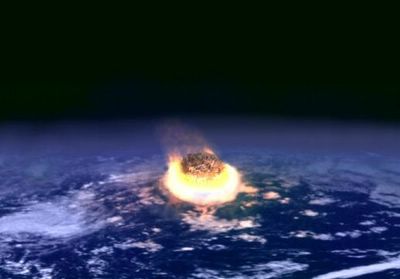
Artist's impression of a major impact event.

Terrestrial Impact Craters , part of the Lunar and Planetary Institute's web site, gives a good overview into the subject. Here, one will find that there are presently about 120 identified impact craters on earth. It is felt that in all probability there are many more but due to erosion, volcanic and tectonic activity, traces of them have been erased. So, how does one identify an impact crater? According to the LPI site, certain shock metamorphism structures have been associated with impact sites:
* an abundance of siderophile elements
* shatter cones
* shocked quartz
* diaplectic glass
* high-pressure mineral phases such as stishovite
Extremely high pressure produces shock effects. (On the site MIAC one will find a picture and an explanation of how shatter cones are formed. The site states that the presence of shatter cones is sure evidence of an impact since the only other way that they can form is by nuclear explosion. Next, there is a picture of the feldspar mineral plagioclase , part of which has been changed to diaplectic glass, which happens at high pressure. There is also a picture of shocked quartz. Quartz does not show cleavage planes ordinarily but under high pressure can form parallel pseudo-cleavage planes, another indication that an impact has occurred.) Stishovite or silicon dioxide (SiO2) forms at very high pressures but not necessary high temperatures, the exact conditions that would exist at an impact site. Siderophile (having an affinity for metallic iron or iron-like ) elements (iron, cobalt, nickel, gold and palladium) are found most abundantly in the earth's core. (Observed relative abundances of elements gives a brief discussion of how elements separate out in a gravitational field.) It is therefore theorized that a high concentration of siderophile elements at the earth's surface is probably due to an extra-terrestrial source, such as a meteorite.
Now that one know how to identify an impact site, what does an impact crater look like? The site Terrestrial Impact Craters identify two types of crater - simple craters and complex craters. Complex craters are characterized by a central peak, which forms when the crater floor rebounds from the initial impact. Crater Formation shows a possible scenario for the formation of a complex crater.
Another interesting site is Impact Craters, part of the University of Hawaii's web site. Although the site is about impact crater on the moon, one can use this site to learn some "crater" jargon. Terms such as impactor, ejecta, rays and central uplift are defined and illustrated.
Where are these impact craters and approximately when did the impacts take place? Terrestrial Impact Craters , lists 20 terrestrial impact sites with great pictures and short descriptions. The NASA's site Exploration features a map of the earth with the positions of various craters marked. There is a sliding scale at the bottom allowing one to go back approximately 1970 million years then move forward to see the order of impact. Additional information on locating impact craters can be found in the Earth Impact Database . This site hosts a database listing all known terrestrial impact structures.
After having learnt so much about impact craters, a visit to one would seem to be in order. How about Meteor Crater a.k.a. Barringer Meteorite Crater in Arizona? One can read about the history of the crater then take the virtual tour around the rim. After getting back from the tour, one can view the animation of the impact. Anyone wishing to discover more about the Barringer Meteorite Crater can drop by their official site . There is a super article about how it was determined that the Barringer Crater was indeed an impact site.

Barringer Crater in Arizona

Finally, the site National Geographer's Asteroids-Deadly Impact is worth a visit. One can become an agent and solve the mysterious cases of the extraterrestrial perpetrators :-).
No comments:
Post a Comment